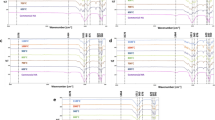Abstract
Hydroxyapatite ceramics technology is examined. Disperse systems and their evolution in each process state are determined. Data from gravimetric and dilatometric analysis and scanning microscopy are reported. The aggregate distribution by size in the initial powder and the grain distribution by size in the sintered ceramic are compared. The inheritance of the properties of the initial powders by the structure characteristic of ceramic materials is demonstrated.
Similar content being viewed by others
References
E. S. Lukin, “Modern high-density oxide ceramic with adjustable microstructure. Part 1: Effect of aggregation of oxide powders on sintering and the microstructure of the ceramic,” Ogneup. Tekh. Keram., No. 1, 5–14 (1996).
W. M. Sigmund, N. S. Bell, and L. Bergstrom, “Novel powder-processing methods for advanced ceramics,” J. Am. Ceram. Soc., 83(7), 1557–1574 (2000).
J. A. Lewis, “Colloidal processing of ceramics,” J. Am. Ceram. Soc., 83(10), 2341–2359 (2000).
A. P. Osokin and E. N. Potapova, “Composition, structure, and properties of oxide-salt melts,” Steklo Keram., No. 9, 44–50 (2003).
E. S. Lukin and N. A. Makarov, “Kinetics of sintering of alumina ceramic with an additive of eutectic composition,” Steklo Keram., No. 1, 22–24 (2000).
L. M. Sulimenko and B. S. Al’bats, Agglomeration Processes in Production of Construction Materials [in Russian], VNIIÉSM, Moscow (1994).
Yu. E. Pivinskii and O. G. Us’yarov, “A new generation of nonmolded refractories,” Novye Ogneupory, No. 1, 35–41 (2006).
J. H. Adair, “Colloidal lessons learned for dispersion of nanosize particulate suspensions,” in: Lessons in Nanotechnology from Traditional and Advanced Ceramics, Tecna Group, Faenza (2005), pp. 93–145.
O. Vasilikiv, Y. Sakka, and V. Skorokhod, “Low-temperature processing and mechanical properties of zirconia and zirconia-alumina nanoceramics,” J. Am. Ceram. Soc., 86(2), 299–304 (2003).
I. Ya. Guzman (ed.), Chemical Engineering for Ceramics: A University Textbook [in Russian], OOO RIF “Stroimaterialy”, Moscow (2003).
F. F. Lunge, “Powder processing science and technology for increased reliability,” J. Am. Ceram. Soc., 72(1), 3–15 (1989).
A. D. Zimon, Colloid Chemistry [in Russian], Agar, Moscow (2003).
Yu. G. Frolov, Course in Colloid Chemistry (Surface Phenomena and Disperse Systems) [in Russian], Khimiya, Moscow (1982).
Chemical Encyclopedia [in Russian], Vol. 2, Moscow (1990).
Yu. S. Pervushin, Composite Materials: A Handbook [in Russian], Moscow (1990).
Clarke R. David, “Interpenetrating phase composites,” J. Am. Ceram. Soc., 75(4), 739–749 (1992).
V. I. Putlyaev and T. V. Safronova, “The new generation of calcium phosphate biomaterials: the role of phase and chemical compositions,” Steklo Keram., No. 3, 30–33 (2006).
A. Yu. Malysheva, B. I. Beletskii, and E. B. Vlasova, “Structure and properties of composite materials for medical applications,” Steklo Keram., No. 2, 28–31 (2001).
L. L. Hench, “Bioceramics,” J. Am. Ceram. Soc., 81(7), 1705–1728 (1998).
N. G Klyuchnikov, Handbook of Inorganic Synthesis [in Russian], Khimiya, Moscow (1965).
Satyabrata Si, Atanu Kotal, Tarun K. Mandal, et al., Chem. Mater., 16, 3489–3496 (2004).
T. V. Safronova, V. I. Putlayev, A. V. Belyakov, and M. A. Shekhirev, “Sintering of HAP precipitated from solutions containing ammonium nitrate and PVA,” in: Proc. of MRS Fall 2005: Symposium Q “Degradation Processes in Nanostructured Materials, pp. 0887-Q 06-10.
O. A. Avramenko, T. V. Safronova, and V. I. Putlyaev, “Ceramic materials based on Ca-deficient hydroxyapatite,” in: Proceedings of the Conf. Current Problems in Modern Inorganic Chemistry and Materials Science” [in Russian], Moscow (2005), p. 1.
Author information
Authors and Affiliations
Additional information
__________
Translated from Steklo i Keramika, No. 1, pp. 21–25, January, 2007.
Rights and permissions
About this article
Cite this article
Safronova, T.V., Putlyaev, V.I., Shekhirev, M.A. et al. Disperse systems in calcium hydroxyapatite ceramics technology. Glass Ceram 64, 22–26 (2007). https://doi.org/10.1007/s10717-007-0006-7
Issue Date:
DOI: https://doi.org/10.1007/s10717-007-0006-7




